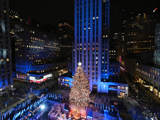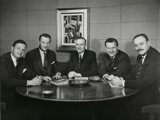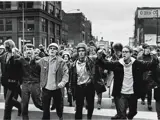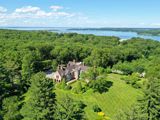Every year, at the end of November, in the plaza in the middle of Rockefeller center, on 5th Avenue, in New York City, a gigantic Christmas tree is lit: it marks the beginning of the much-awaited holiday season. Under the tree, a traditional ice rink is the main attraction for tourists and locals.
The stunning Arte Deco complex, with dozens of shops and restaurants (including an internal subway stop), was built by the Rockefeller family, and is known for its iconic landmark: the GE Building, headquarters to the historic US multinational.
The idea for a commercial and office center was first proposed by the magnate John D. Rockefeller Jr. in the 1920s, as a way to help stimulate the economy in the wake of the Great Depression. The Black Monday of 1929 sent Wall Street and the entire world into the first global recession (a bleak record that stood unbeaten until Lehman Brothers crack in 2008). A new theory from a young economist, called John Maynard Keynes, suggested governments should increase public spending in order to create jobs and build useful infrastructure. So the millionaire Rockefeller enlisted dozens of architects, engineers, and artists to develop a plan for the project, and construction began in 1930, in the middle of the economic crisis, with people starving and others committing suicide because they had no more money.
The complex was built in stages, with the first building opening in 1933. When the GE Building was completed in 1939, it was the tallest building in the world at the time, stealing the record from the Flatiron, the iconic NYC building which was a generation older.
After this magnificent skyscraper, John D. Rockefeller became the most famous and celebrated businessman in the world: his family was already famous tough. He had the suffix Jr. - from Latin “Junior”, the younger - because he bore the same name of his grandfather. The Rockefellers are the most prominent American business family whose fame spans globally: The family has a long history of philanthropy, and members of the family have been influential in a variety of fields, including politics, business, and the arts. They made their fortune in the oil industry. The story starts in 1839: Eliza Davison, the wife of William Avery Rockefeller, a small businessman and con artist, gave birth to a boy named John D. Rockefeller in the small village of Richford, upstate New York. He was the second of six children. Since his youth, John seems to be an apt pupil: he began his career in business as a clerk aged only 16. But destiny had much more in store for him: during his 20’s he envisages the future in an up-and-coming business: the rising oil industry. In 1870, only 31, he, Harry Flager, and Stephen Harkness establish the Standard Oil Company.
In the 1880s, while in Sicily a nobleman is revolutionizing European literature by chronicling a derelict and poor peasants’ dynasty another one is booming: the Rockefellers control more than 90% of the oil refining capacity in the United States. John D. Rockefeller is the first common man in the United States, to become a billionaire. Until then, only noblemen and monarchs could have such wealth. Under Rockefeller's leadership, Standard Oil became one of the largest and most successful businesses in the world, maybe too much. In achieving this position, Standard violated its Ohio charter, which prohibited the company from doing business outside the state. In 1911 the U.S. Supreme Court ruled that Standard Oil be dissolved under the Sherman Act and be split into 34 companies. It was the first antitrust decision in history.

WEALTH & POLITICS
Despite facing significant criticism and legal challenges, Rockefeller's business practices helped to revolutionize the oil industry while becoming a philanthropist. He donated large sums of money to a variety of causes, including education, medical research, and the arts. Rockefeller Junior was also involved in the family business and continued the tradition of philanthropy: he supported a variety of charitable causes, including the construction of the United Nations headquarters in New York. The gene of business was running in the family. David Rockefeller, son of Rockefeller Jr., had a great career in investment banking. He became chairman and CEO of the Chase Manhattan Bank, which was later merged with Jp Morgan. Wealth very often goes hand in hand with politics in the US: no surprise John D. Rockefeller Jr. was a delegate to the 1924 Democratic National Convention. Nelson Rockefeller, a grandson of the founder Rockefeller and brother of John, was even better: he served as the 41st Vice President of the United States under President Gerald Ford. History fun fact: Ford is the only American president who has never been elected because he came into office after Richard Nixon resigned due to the Watergate Scandal. When John Davison Rockefeller Senior died in 1937, at the remarkable age of 95, his net worth was estimated to be around 1.5 million dollars, which is equivalent to over 26 billion in today's dollars.

ALL THE CRITICS LOVE YOU IN NEW YORK
The Rockefeller Center has not always been a source of glory. The family has also faced criticism for the development: some argued the project displaced low-income residents and small businesses, in favor of luxury real estate which benefited the rich. In the early 20th century, Rockefeller Sr. was the target of several assassination attempts. In 1912, a man named Charles Jones tried to shoot him with a gun but was tackled by security guards before he could fire. In 1915, another man named Harry Garson attempted to bomb Rockefeller's office, but the bomb failed to detonate. In the 1970s, members of the Rockefeller family were targeted by the radical left-wing group called the Weather Underground. The group claimed responsibility for several bombings, including an attack on a family property in New York City. Involvement in the oil industry, particularly in relation to the environment, has always been an issue for the family. Repeatedly over time, it’s been argued that the family has not done enough to address the negative impacts of fossil fuels on the environment.

A REAL ESTATE DYNASTY
Such an enlarged and rich family deserved an adequate house to call it home. This adequate nest has been located in the tranquility of the Upper East Side in NYC. For almost 70 years, the Rockefellers lived at 146 East 65th Street, the most elegant city neighborhood. David bought the property in 1948 when he was chairman at Chase for his wife Peggy. The nearly 10,000-square-foot Colonial Revival floor-to-ceiling house, spanning through five floors, including 2,958 square feet of outdoor space, was originally built in 1924: Rockefeller tapped architect Mott Schmidt to renovate its interior in the 1970s. In the same year, Rockefeller’s wife, Peggy, designed a seven-bedroom house inside a 14.5-acre estate in Seal Harbor, an enchanting bay in Mount Desert town: “Ringing Point” features a granite swimming pool and circular rose garden.
After David Rockefeller died in 2017, his heirs put the NYC family townhouse up for sale. It was listed for over 30 million: in 2018 a buyer paid US $20 million to acquire it. The same went for Ringing Point with an asking price of US $19 million. It sold for the same amount and all the proceeds went to charity. On the market, for $18.5 million, went another property: the prestigious Mill Neck, the weekend enclave located north of New York celebrating Tudor architecture. The Rockefeller family has a long tradition of summering in Maine: they own another summer house in Mount Desert Island called "The Eyrie".

HEIR & SPARE
Mark Fitler Rockefeller, born in 1967, is the fourth-generation member of the dynasty. He is the younger son of former US Vice President Nelson. He spent a career in finance: he was an associate at Chase Securities, the same bank as his uncle David. In 1999 he was elected chairman of the non-profit organization, Historic Hudson Valley an organization founded in 1951 by his grandfather, Rockefeller Jr. He has 4 children with his former wife, from whom he divorced in 2020: they will be the Rockefeller of the future.
Generations come and go but controversy still sparks among the family. In 2013 an inquiry about Federal farm subsidy programs, it was reported that 1,500 affluent New Yorkers had received payments. Among them was Rockefeller, who received US $340.000 in taxpayer money over the course of ten years from 2001 to 2011 for allowing farmland to return to its natural condition.






About the author
LFG+ZEST SA